Interpretative summary of recent papers
Evaluation of in vitro ruminal fermentation of ensiled fruit byproducts and their potential for feed use
Shimaa A Mousa, Pradeep K. Malik, Atul P. Kolte, Raghavendra Bhatta, Shigemitsu Kasuga, and Yutaka Uyeno
Asian-Australasian Journal of Animal Sciences, in press.
This study aimed to evaluate whether ensiled fruit byproducts (grape pomace, wild grape pomace, and persimmon skin) are effective in mitigating methane emission from ruminants by conducting in vitro assessments. Reduced methane production and a proportional change in total volatile fatty acids (especially enhanced propionate proportion) was noted in bottles containing the FBs compared with that in the control (without FB). In addition, we found lower gene copy number of archaeal 16S rRNA and considerably higher levels of one of the major fibrolytic bacteria in the bottles containing FBs than in the control, particularly, when it was included in a forage-based feed. However, in the following cultivation experiment, we observed that FBs failed to exhibit a significant difference in methane production with or without polyethylene glycol. Ensiling of FBs affected rumen fermentation patterns and the degree of methane generation. This is primarily because of the compositional changes in the fibrous fraction during ensiling as well as the presence of readily fermented substrates, whereas tannins in these FBs seemed to have little effect on the ruminal fermentation kinetics.
*Feel free to contact the staff for reprints request.
| "Evaluation of in vitro ruminal fermentation of ensiled fruit byproducts and their potential for feed use." Mousa, S. A., Malik, P. K., Kolte, A. P., Bhatta, R., Kasuga, S., and Uyeno, Y. Asian-Australasian Journal of Animal Sciences, in press.【Regular paper】 Interpretative summary |
|
| "Changes in gut microbial ecology and immunological responses of mice fed the insoluble fraction of Brassica rapa L. that was fermented or not." Tanaka, S., Yamamoto, K., Hamajima, C., Takahashi, F., Yamada, K.,Furuya, K., and Uyeno, Y. Microbes and Environments, 32:268-274, 2017.【Regular paper】 |
|
| "Effects of supplementing an active dry yeast product on rumen microbial community composition and on subsequent rumen fermentation of lactating cows in the mid-to-late lactation period." Uyeno, Y., Akiyama, K., Hasunuma, T., Yamamoto, H., Yokokawa, H., Yamaguchi, T., Kawashima, K., Itoh, M., Kushibiki, S., and Hirako, M. Animal Science Journal 88:119-124, 2017.【Regular paper】 |
|
| "Consecutive reticuloruminal pH monitoring in dairy cows fed diets supplemented with active dry yeast during the transition and mid-lactation periods." Hasunuma, T., Uyeno, Y., Akiyama, K., Hashimura, S., Yamamoto, H., Yokokawa, H., Yamaguchi, K., Itoh, M., Mizuguchi, H., Sato, S., Hirako, M., and Kushibiki, S. Animal Feed Science and Technology 221:215-225, 2016.【Regular paper】 |
|
| "Relationship of enhanced butyrate production by colonic butyrate-producing bacteria and immunomodulatory effects in normal mice fed insoluble fraction of Brassica rapa L." Tanaka, S., Yamamoto, K., Yamada, K.,Furuya, K., and Uyeno, Y. Applied and Environmental Microbiology 82:2693-2699, 2016.【Regular paper】 |
|
| "Effects of supplementation with cellooligosaccharides on growth performance of weaned calves on pasture." Kido, K., Tejima, S., Nagayama, H., Uyeno, Y., Ide, Y. and Kushibiki, S. Animal Science Journal 87:661-665, 2016.【Regular paper】 |
|
| " Immunization approaches in livestock methane amelioration" Uyeno, Y. in Livestock Production and Climate Change (ISBN: 9781-78064-4325) , CABI Publishing, pp. 304-317. 【 Book chapter】 |
|
| "Generation of dipeptidyl peptidase-IV-inhibiting peptides from [Beta]-lactoglobulin secreted by Lactococcus lactis. Shigemori, S., Oshiro, K., Wang, P., Yamamoto, Y., Wang, Y., Sato, T., Uyeno, Y. and Shimosato, T. BioMed Research International, Article ID 393598, 2014.【Regular paper】 |
|
| "Nutritional management of dairy cattle under heat stress conditions and its impact on the rumen microbial community structure" Uyeno, Y. Global Animal Nutrition Conference 2014, Bengaluru, India.【Invited talk】 |
|
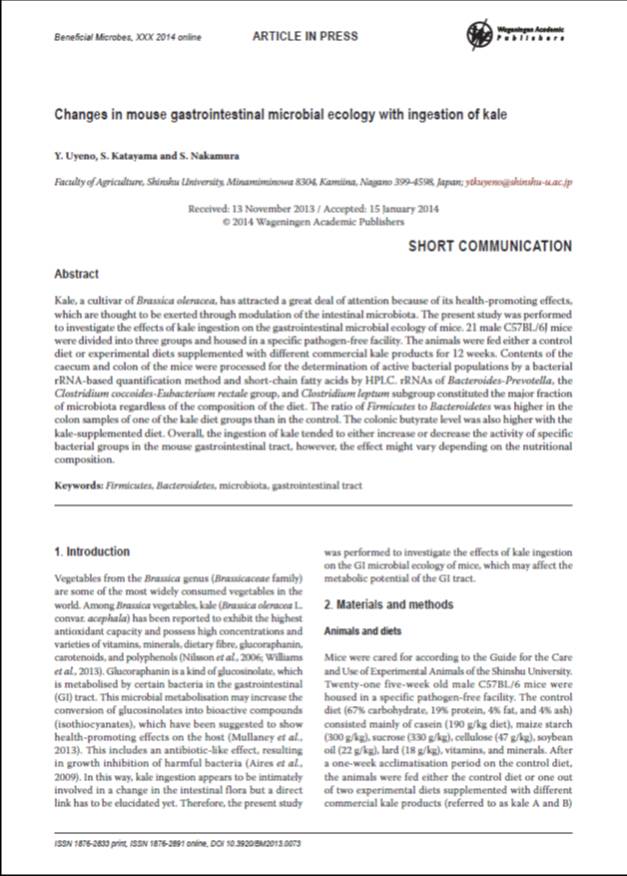 |
"Changes in mouse gastrointestinal microbial ecology with the ingestion of kale" Uyeno, Y., katayama, S. and Nakamura, S. Beneficial Microbes, 5:345-349, 2014.【Short Communication】 |
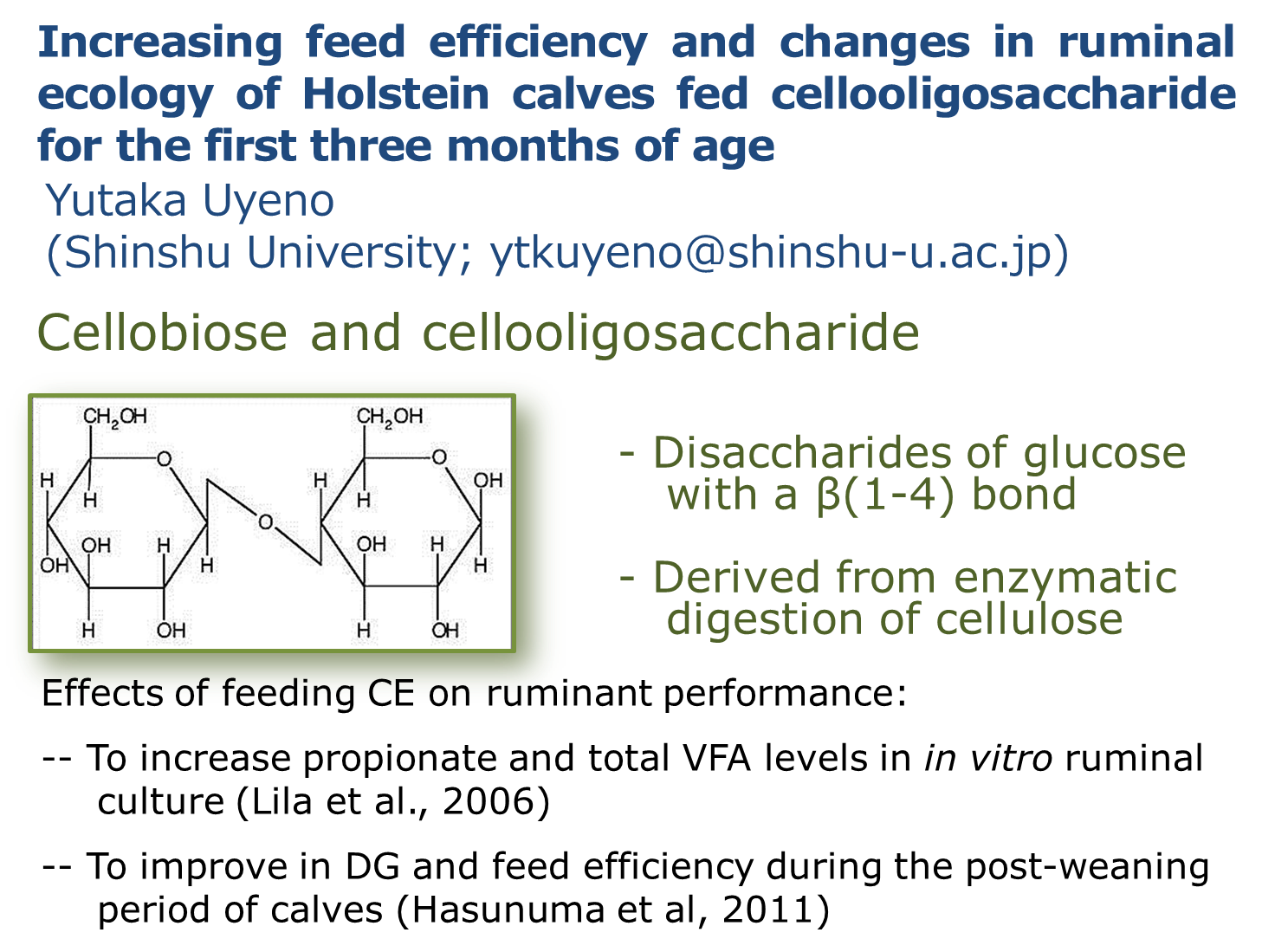 |
"Increasing feed efficiency and changes in ruminal ecology of Holstein calves fed cellooligosaccharide for the first three months of age" Uyeno, Y. China-Korea-Japan Joint Rumen Symposium 2013.【Oral presentation】 |
| "The effect of deoxynivalenol and zearalenone on rumen fermentation and their degradation by rumen microorganisms in vitro" Owada, H.,Ueno, Y., Nade, T., Koyama, N., Sato,K. and Itabashi, H. China-Korea-Japan Joint Rumen Symposium 2013.【Oral presentation】 |
|
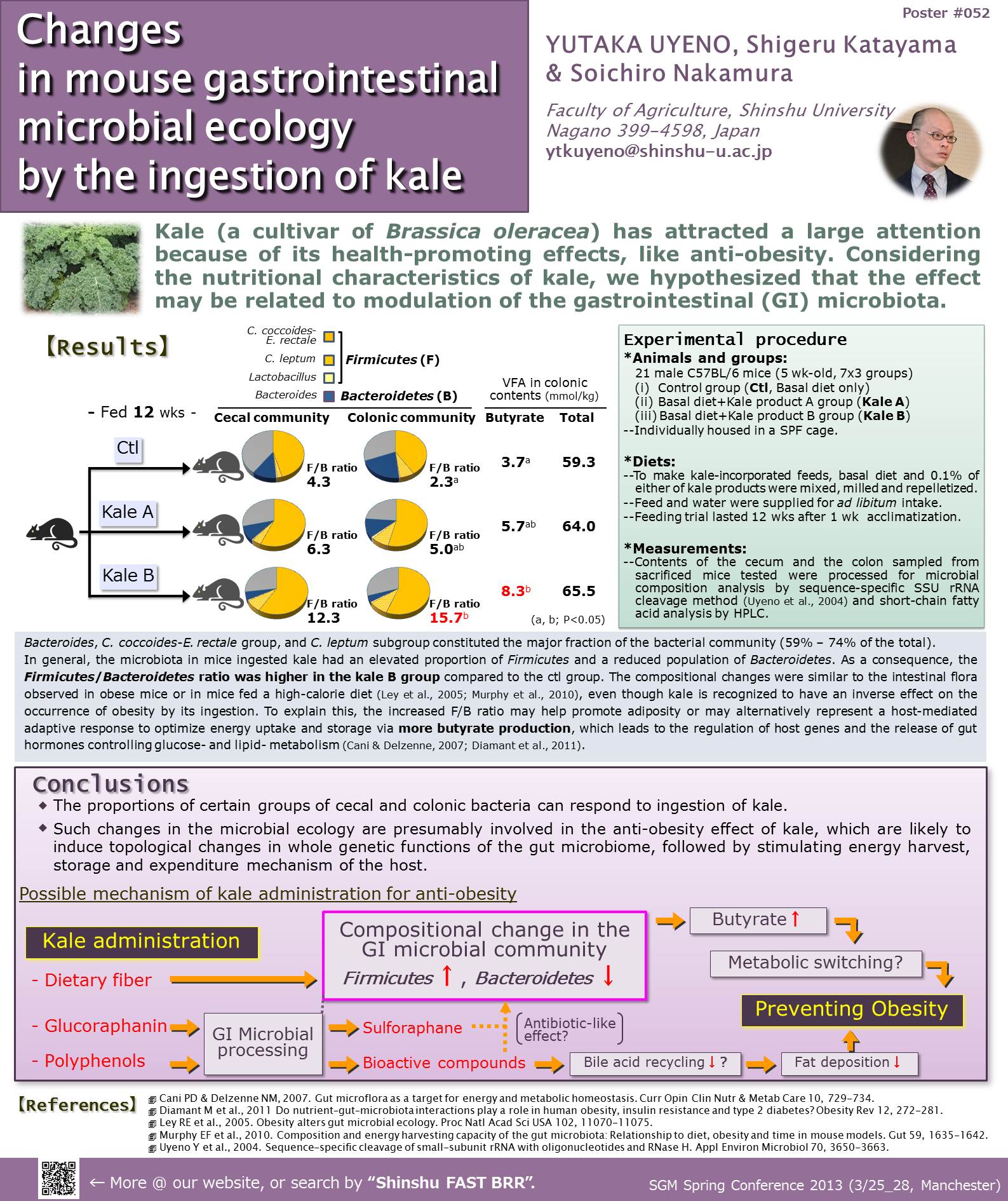 |
"Changes in mouse gastrointestinal microbial ecology by the ingestion of kale" Uyeno, Y., katayama, S. and Nakamura, S. SGM Spring Conference 2013.【Poster presentation】 |
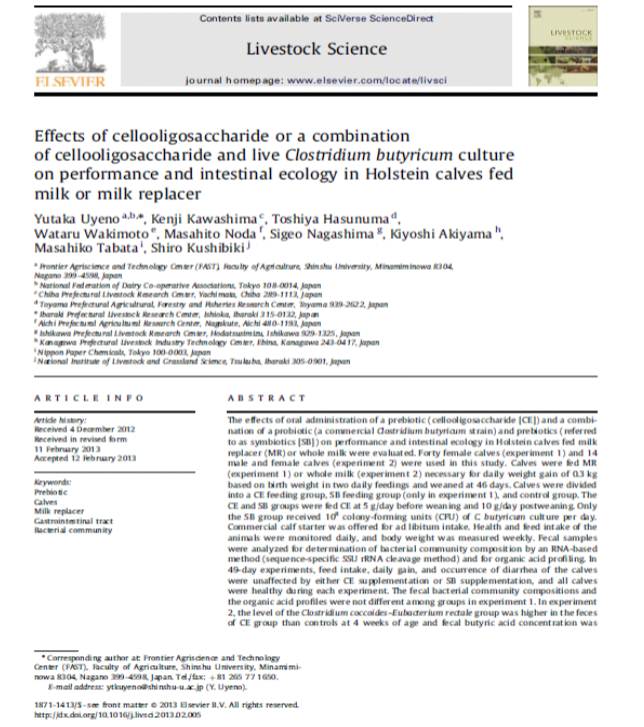 |
"Effects of cellooligosaccharide or a combination of cellooligosaccharide and live Clostridium butyricum culture on performance and intestinal ecology in Holstein calves fed milk or milk replacer" Uyeno, Y., Kawashima, K., Hasunuma, T., Wakimoto, W., Noda, M., Nagashima, S., Akiyama, K., Tabata M. and Kushibiki, S. Livestock Science 153:88-93, 2013.【Regular paper】 |
 |
“Dynamics and functionalities of animal intestinal microflora explored with molecular approaches” Uyeno, Y. A colloquium at Philippine Carabao Center, 2012.【Invited talk】 *Abstract(PDF) *A pdf file of the presentation is also available upon request. |
 |
"Fecal bacterial community succession of Holstein calves and its modulation by providing prebiotics fed with milk replacer" Uyeno, Y. The 15th AAAP Animal Science Congress of the Asian-Australasian Association of Animal Production Societies, 2012.【Poster presentation】 |
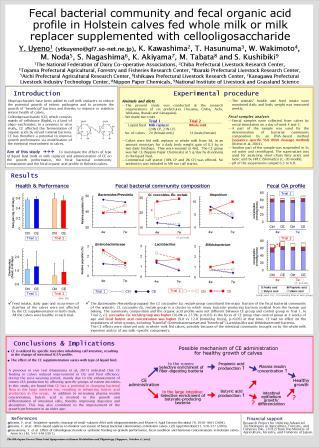 |
"Fecal bacterial community and fecal organic acid profile in Holstein calves fed whole milk or milk replacer supplemented with cellooligosaccharide" Uyeno, Y., Kawashima, K., Hasunuma, T., Wakimoto, W., Noda, M., Nagashima, S., Akiyama, K., Tabata M. and Kushibiki, S. The 8th Japan-Korea-China Joint Symposium on Rumen Metabolism and Physiology, 2011.【Poster presentation】 |
 |
"An rRNA-based analysis for evaluating the effect of heat stress on the rumen microbial composition of Holstein heifers" Uyeno, Y., Sekiguchi, Y., Tajima, K., Takenaka, A., Kurihara, M. and Kamagata, Y. Anaerobe 16:27-33, 2010.【Regular paper】 |
 |
"rRNA-based analysis to monitor succession of faecal bacterial communities in Holstein calves" Uyeno, Y., Sekiguchi, Y. and Kamagata, Y. Letters in Applied Microbiology, 51:570-577, 2010.【Regular paper】 |
 |
"Difference in the nature of tannins on in vitro ruminal methane and volatile fatty acid production and
on methanogenic archaea and protozoal populations" Bhatta, R., Uyeno, Y., Tajima, K., Takenaka, A., Yabumoto, Y., Nonaka, I., Enishi, O. and Kurihara, M. Journal of Dairy Science 92:5512-5522, 2009.【Regular paper】 |
 |
Impact of consumption of probiotic lactobacilli-containing yogurt on microbial composition in human feces" Uyeno, Y., Sekiguchi, Y., and Kamagata, Y. International Journal of Food Microbiology 122:16-22, 2008.【Regular paper】 |
 |
"The effect of heat stress on rumen microbial composition analyzed by sequence-specific rRNA cleavage method" Uyeno, Y., Sekiguchi, Y., Tajima, K., Takenaka, A., Kurihara, M. and Kamagata, Y. 2007 ADSA PSA AMPA ASAS Joint Meeting【Poster presentation】 |
 |
"Evaluation of group-specific,16S rRNA-targeted scissor probes for quantitative detection of
predominant bacterial populations in dairy cattle rumen" Uyeno, Y., Sekiguchi, Y., Tajima, K., Takenaka, A., Kurihara, M. and Kamagata, Y. Journal of Applied Microbiology 103:1995-2005, 2007.【Regular paper】 |
 |
"Quantitative analysis of rRNA populations of bacterial groups in dairy cattle rumen samples by sequence-specific small-subunit rRNA cleavage method" Uyeno, Y., Sekiguchi, Y., Tajima, K., Takenaka, M. and Kamagata, Y. 21st ASM General Meeting, 2005【Poster presentation】 |
 |
"Sequence-specific cleavage of small-subunit (SSU) rRNA with oligonucleotides and RNase H:
a rapid and simple approach to SSU rRNA-based quantitative detection of microorganisms" Uyeno, Y., Sekiguchi, Y., Sunaga, A., Yoshida, H., and Kamagata, Y. Applied and Environmental Microbiology 70:3650-3663, 2004.【Regular paper】 |